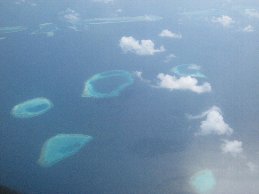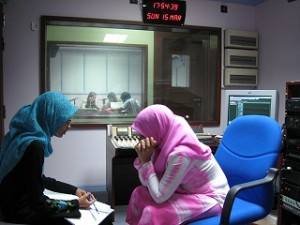Maldives
Building Resilience to Tsunamis in the Indian Ocean, the Maldives (UNISDR/ADRRN Project “Selamat”)
The Republic of Maldives is an archipelago of islands stretching over 820 km north-south and 128 km east-west. Maldives comprises 1,190 small islands which are clustered into 26 natural atolls, which for administrative purposes are grouped into 20. Of the more than 1000 islands, only 199 islands are inhabited, and another 80 islands have been developed into tourist resorts. Over 80% of the land area is less than 1 meter above sea level. All of the human settlement, industry and vital infrastructure of the Maldives lie very close to the shoreline, within 0.8 to 2 m of mean sea level.
The 7th National Plan of the Maldives identifies Environmental Management as one of the top priorities. The low lying islands of the Maldives are very sensitive to the impacts from predicted climate change and extremely vulnerable to natural disasters as demonstrated by the December 2004 tsunami.
Based on field visits conducted to collect primary and secondary data for vulnerability and risk assessments, areas for field interventions such as Coastal bioshiled, nutritional model home garden, the Community Resource Centre and Solid Waste Management to build resilient island communities were identified for the Island Milandhoo in Shaviyani Atoll as a model Island with other 4 Island in the Atoll (the project Selamat).
The project Selamat in Shaviyani has been designed and will be implemented at island/atoll level in the lines of 3rd and 4th priority identified in the Hyogo Frame of Action: Building a culture of safety and Resilience and Reducing the Risk in the key Sectors.

Sub-projects
There are 4 components for the Selamat project in the Maldives other than Disaster Risk Reduction planning and training
Coastal Bioshield
Nutritional Home Kitchen Gardens
Community Resource Centre
Solid Waste Management
Reports:
Progress Reports:
Training on Development of Contents on Disaster Risk Reduction (DRR) for the Mass Media in Maldives(supported by UNISDR)
The focus of this program is to organize training workshops on DRR and to develop training materials for staff of local media groups in Maldives. Knowledge and experiences of other countries on DRR media programs, especially from Japan and India, are brought into the training. Local stakeholders such as the National Disaster Management Centre (NDMC) and other government agencies and local communities are well involved in order to ensure relevance and acceptability, and to enable media professionals to utilize their networks established through the training for future activities.
Project Country : Republic of Maldives
Project Period : Jul 2008 – Mar 2009
Background
The NDMC has been working to conduct training programs with international organizations and NGOs to raise awareness of the importance of DRR to create well-prepared communities against future natural disasters. However, due to the physical isolation of islands in Maldives, accomplishing this task is a huge challenge.
One of the most influential sources of information to local people in Maldives, like in any other country, is the mass media, especially television and radio. According to our baseline study on another project in collaboration with the NDMC and several partners, it was found that many local people get knowledge on environmental problems they are facing through mass media. It is well known that mass media plays a critical role at the time of disaster for early-warning, in addition to that for wider dissemination of the importance of pre-disaster mitigation, mass media can also be influential intermediate at local/individual level.
Saying local media companies are keen to collaborate in such DRR initiatives, the NDMC recognizes that their capacity to produce such DRR related programs is limited, which led the NDMC to request SEEDS Asia for more intervention to build capacity of local media groups on DRR for wider dissemination of the importance of DRR to the public.
Objectives
Capacity building of the local media groups on disaster risk reduction themes for the purpose of
1.Raising awareness of local communities towards natural disasters as highly possible risk like environmental issues currently they are working on.
2. Establishing networks among the mass media, Maldivian governmental agencies and local community-based organizations in order to improve early-warning systems and communication systems in emergency.
Activities
1. Consultative meeting with National Disaster Management Centre and local media stations
2. Needs assessment of Maldives local media groups
3. Study on existing materials on the role of media for natural disasters
4. Consultative meetings with local media stations in Japan and India to study good practices on media and DRR
5. Field survey on local community and media
6. Develop the training materials on DRR for the mass media
7. Conduct training workshop in Male for local media staffs
8. Broadcast pilot radio program through local radio station

Report: